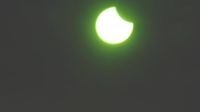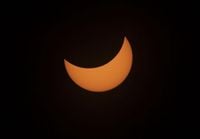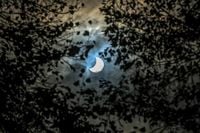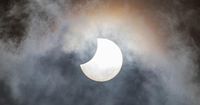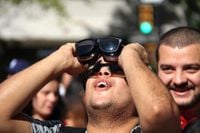On March 29, 2025, a partial solar eclipse graced the skies over Poland, offering a unique astronomical spectacle for enthusiasts and casual observers alike. The eclipse began at 11:40 AM, peaked at 12:24 PM, and concluded at 1:07 PM, during which the Moon covered approximately 11% of the Sun's disk, giving it a subtly nibbled appearance.
Jakub Tokarek from the Astronomical Observatory of Adam Mickiewicz University in Poznań explained the phenomenon, stating, "A solar eclipse occurs when our natural satellite is positioned between the Earth and the daytime star. Due to the slight tilt of the Moon's orbit to the ecliptic, this event does not happen every month but only 2-3 times a year." This partial eclipse was particularly noteworthy as it was visible across the entire country, although the extent of coverage varied by location.
According to forecasts, the eclipse's maximum obscuration of the solar disk would range from about 12% near Wrocław to 26% in Szczecin, with Warsaw experiencing around 16% coverage. The phenomenon was expected to reach its peak visibility around 12:30 PM, making it a prime moment for observers.
For those eager to witness the event, special sky shows were organized at the Astronomical Observatory located at Słoneczna 36 in Poznań. These events, running from 11:30 AM to 1:15 PM, offered free admission and allowed attendees to safely observe the eclipse under the guidance of experts. This was an excellent opportunity for the public to delve into the wonders of astronomy and learn about the science behind solar eclipses.
However, safety precautions were emphasized for anyone planning to view the eclipse. Observers were advised never to look directly at the Sun without proper protection, as this could lead to severe eye damage. Recommended viewing methods included using specialized solar filter glasses, mylar film, or welding glass with the appropriate darkening level.
Weather conditions played a crucial role in the visibility of the eclipse. Grażyna Dąbrowska, a meteorologist from IMGW (Institute of Meteorology and Water Management), indicated that the best weather for viewing the eclipse would be in regions such as Suwalszczyzna, Mazury, Mazowsze, Lubelszczyzna, eastern Pomerania, and Kujawy. These areas were expected to experience minimal cloud cover, providing ideal conditions for observation. In contrast, more clouds were anticipated over Western Pomerania, Greater Poland, Lubusz Land, and Lower Silesia, with the southern edges of Poland, including Upper and Lower Silesia, Małopolska, and Podkarpacie, facing the most cloud cover and potential rain.
Despite these challenges, some meteorologists remained hopeful for breaks in the clouds, suggesting that viewers in those areas might still catch glimpses of the eclipse. Karol Wójcicki, a popularizer of astronomy and author of the blog "Z głową w gwiazdach," noted that the Moon's shadow would almost reach the North Pole, allowing nearly the entire European continent to observe the partial eclipse at varying intensities. He reported that the maximum phase of the eclipse in Świnoujście would cover 16.5% of the solar disk, while Szczecin would reach 15.4%. Observers in cities like Rzeszów, Warsaw, and Kraków could expect coverage between 6-11%.
For those unable to observe the eclipse in person, a live transmission was available on YouTube, courtesy of nocneniebo.pl, featuring a solar telescope equipped with an H-Alpha filter. This broadcast allowed viewers to not only see the Moon obscuring the Sun but also to catch details of the solar surface, such as sunspots and prominences. The transmission commenced with the beginning of the eclipse and continued until around 1:12 PM, ensuring that everyone had the chance to experience this astronomical event.
Looking ahead, the next deep solar eclipse visible from Poland is scheduled for August 12, 2026, at sunset, which promises to be an even more spectacular sight. This event will be observable from various locations across Poland, making it a date to mark on the calendars of astronomy enthusiasts.
As part of the ongoing interest in space and astronomy, Poznań is set to host the International Astronautical Congress (IAC) in 2027, which is expected to attract nearly 10,000 guests from around the globe. This prestigious event will further establish the city as a hub for space exploration and scientific discussion.
In conclusion, the partial solar eclipse on March 29, 2025, served as a reminder of the beauty and wonder of our universe. Whether observed in-person or via online broadcasts, this celestial event brought people together in awe of the cosmos, while also highlighting the importance of safety in astronomical observation.
